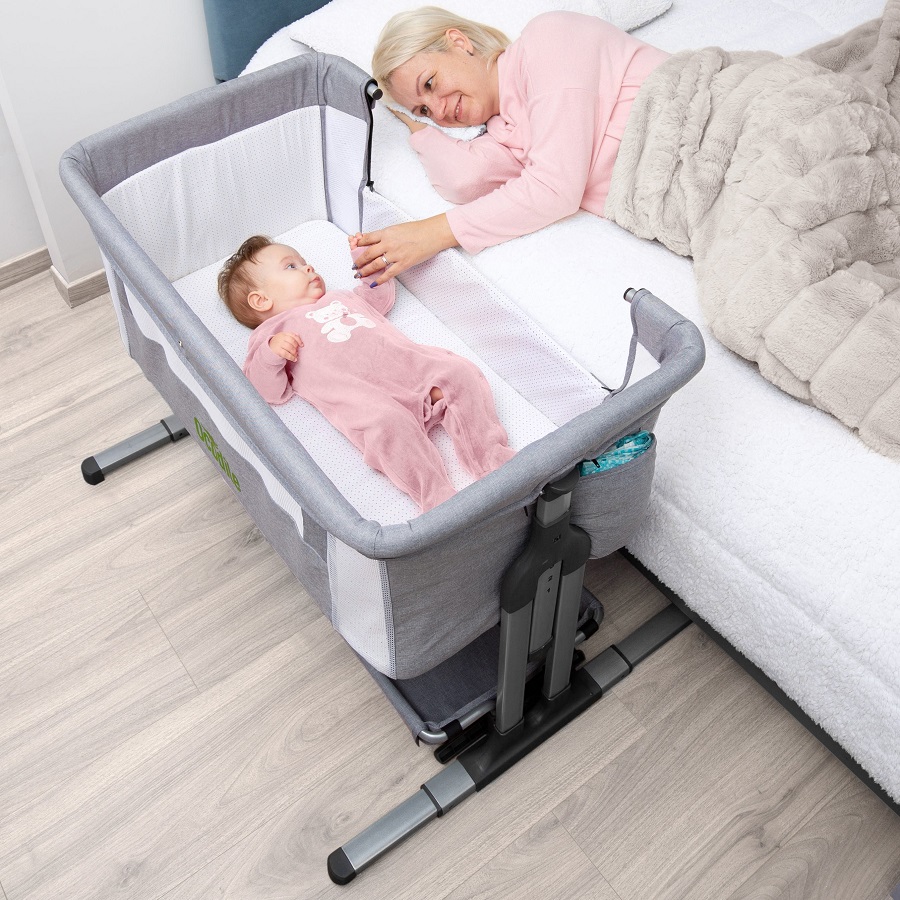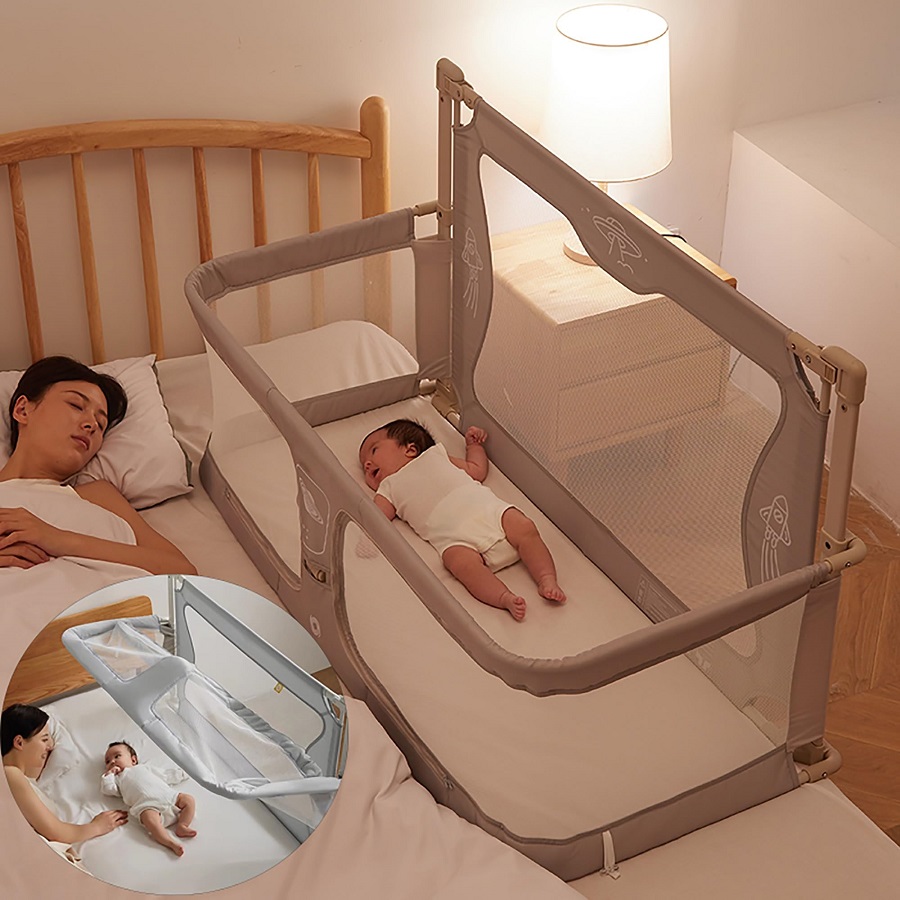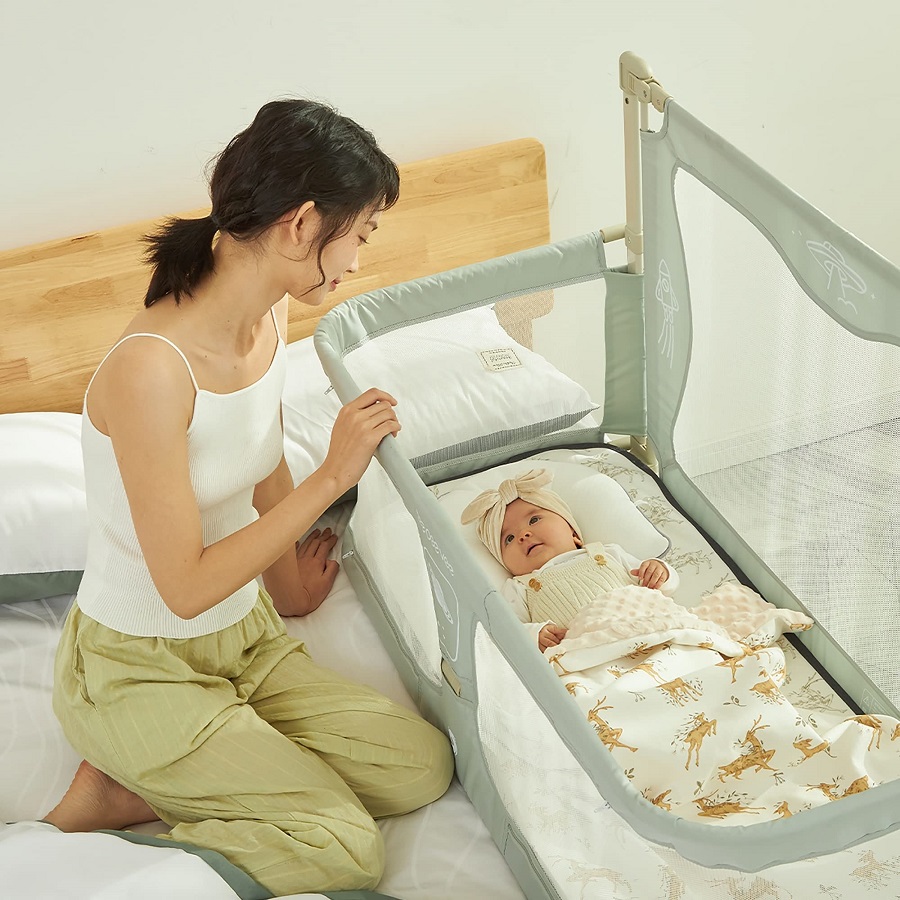What is a Co-Sleeper and How Does It Differ from Co-Sleeping?
When you hear ‘co-sleeping,’ you might think of sharing a bed with your baby. This practice, known as bed-sharing, involves having your infant sleep in the same bed as you. However, many experts, including the American Academy of Pediatrics (AAP), advise against bed-sharing due to safety risks. That’s where a co-sleeper comes in. A co-sleeper is a separate sleep space for your baby that attaches to your bed. This allows your baby to sleep safely by your side without the dangers associated with bed-sharing. It’s a specialized bed that affords you the convenience of having your baby close, while adhering to safe sleep guidelines.
The Pros and Cons of Using a Baby Co-Sleeper Bed
Having a baby co-sleeper bed offers a mix of benefits and drawbacks.
Pros
The main advantage of co-sleeper beds is the close proximity to your baby during the night. This setup can make nighttime feedings and soothing easier, especially for breastfeeding mothers. Co-sleeper beds can also offer peace of mind since you can easily check on your baby. They are designed to adhere to safety guidelines, which is crucial for protecting your little one.
Cons
On the downside, co-sleeper beds have a short lifespan – they’re useful only until your baby starts rolling over or sitting up. You might also find the attached bed cumbersome, as it can hinder your movement in and out of bed. Lastly, these beds require careful setup to ensure they are properly secured and present no risks of gaps between the co-sleeper and the adult bed.

Room-Sharing vs Bed-Sharing: Understanding AAP Recommendations
When it comes to sleeping arrangements with your baby, two terms often crop up: room-sharing and bed-sharing. The American Academy of Pediatrics (AAP) recommends room-sharing for the first six months or longer. This means your baby sleeps in their own safe space within your room, but not in your bed. Bed-sharing, however, is when a baby sleeps in the same bed as their parents. The AAP strongly advises against bed-sharing due to the increased risk of sudden infant death syndrome (SIDS) and other sleep-related deaths. Room-sharing with a baby co-sleeper bed can ease nighttime care, support breastfeeding, and enhance bonding while following AAP’s safety guidelines. It provides an ideal balance, giving your baby their own designated area that aligns with recommendations for reducing SIDS risks.
Essential Criteria for Selecting a Co-Sleeper Bed
When choosing the right co-sleeper bed, you need to keep in mind several key factors.
Safety Standards and Certifications
Prioritize your baby’s safety by selecting a co-sleeper that meets current safety standards. Look for certifications that show the product adheres to recommended guidelines.
Compatibility with Your Bedroom Space
Make sure the co-sleeper fits well in your bedroom. It should easily attach to your bed without causing any inconvenience or safety problems.
Design and Breathability
Choose a co-sleeper with a breathable design. Mesh sides or slatted walls help ensure your baby’s safe sleep environment.
Quality and Comfort
Opt for a co-sleeper made with high-quality materials. Check for a firm mattress that provides comfort and supports safety protocols.
Important Considerations for Co-Sleeper Use
When opting for a baby co-sleeper bed, there are critical points to consider. Here are essential guidelines for ensuring the use of a co-sleeper is safe and beneficial for your baby.
Avoiding Used or Hand-Me-Down Co-Sleepers
It might be tempting to accept a hand-me-down co-sleeper. But safety is key. Always choose a new co-sleeper. This way, you are certain it meets current safety standards. Plus, all parts will be intact. It’s the safest choice for your newborn.
Checking for Missing Parts and Potential Hazards
After buying a new co-sleeper, inspect it carefully. Ensure there are no missing parts. Watch out for potential hazards like sharp edges or loose components. Read the manual carefully and assemble the co-sleeper as instructed. This ensures your baby’s sleep space is secure.
Proper Mattress Fit and Appropriate Bedding
The mattress in the co-sleeper should fit snugly. There shouldn’t be gaps where your baby could get stuck. Only use the mattress that the co-sleeper comes with or one designed for it. Dress the mattress with a fitted sheet that matches the mattress size. Avoid adding pillows, blankets, or toys. They can pose risks to your baby while they sleep.

Transitioning from a Co-Sleeper to a Crib
As your baby grows, it’s essential to transition from a co-sleeper bed to a suitable crib. This change usually happens when your little one becomes more active. They might start rolling over, sitting up, or outgrowing the weight limit for the co-sleeper. These milestones often occur around 4 to 6 months of age. When you notice these signs, it’s time to make the switch to a crib to ensure your baby’s safety during sleep.
Recognizing When It’s Time to Make the Change
Recognizing the right time to move your baby to a crib is crucial for their safety. Pay attention to your baby’s development. Look for them starting to roll over or trying to sit up unassisted. Check the co-sleeper’s weight and size limits too. If your baby is reaching these limits, it’s time to switch to a crib for more space and security.
Features of Convertible Cribs for Growing Babies
Convertible cribs are ideal for babies transitioning from co-sleepers. They adapt to your growing child’s needs. These cribs can turn into toddler beds, daybeds, and sometimes even full-size beds. Many have adjustable mattress heights. This helps keep your little one safe as they start standing and climbing. Plus, convertible cribs are durable. They last through your child’s different stages, offering a practical, long-term solution.
Final Thoughts on Co-Sleepers: Safety and Convenience
When it comes to nighttime parenting, co-sleepers can be a game-changer. They offer the comfort of having your baby close while providing a safe, separate space for sleep. Always choose a co-sleeper that adheres to current safety standards to ensure your baby’s security.
In summary, co-sleepers deliver both safety and convenience for new parents. By keeping your baby within arm’s reach, co-sleepers facilitate easier feedings and allow for quick comforting during the night. However, they should only be used until your baby starts showing signs of mobility, such as rolling over or sitting up, which typically happens by the age of 4 to 6 months.
Make safety a top priority when choosing and using a baby co-sleeper bed. Go for a new, certified product that fits well in your space. Check for a sturdy design, a snug mattress fit, and avoid any additional bedding. When your baby outgrows the co-sleeper, transitioning to a secure crib ensures continued safe sleep.
Remember, the well-being of your baby trumps all. So embrace the convenience co-sleepers offer, but always keep safety at the forefront. They are not just a place for your baby to rest, but an investment in your peace of mind.

Co-sleepers indeed blend convenience with safety, allowing parents to remain close while ensuring a secure sleep environment for their little ones. As babies grow and become more mobile, it’s crucial to transition to a crib to maintain that safety. Regularly review safety standards and recommendations, as they can evolve. Would you like to delve deeper into specific types of co-sleepers or safety tips?
